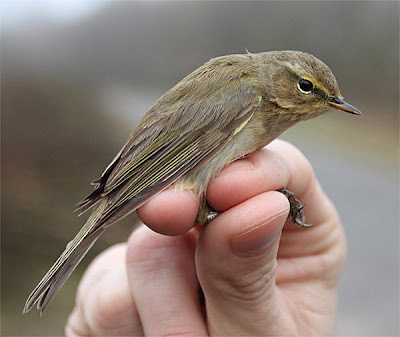Today I decided to visit Botley Wood with a view to cutting in the net rides in readiness for the arrival of 'the barley bird' or common nightingale, to most of you. But alas due to the regular management of the site, all of the scrub in the vicinity of my trapping area from last year had gone! Unfortunately, one of these areas was the territory of a bird that I have been capturing for the last six years, this year would have been its seventh, and possibly would have been a national longevity record for the species.......I will keep you posted if it returns.
With no net rides to cut in I decided to put up some nets and try to catch some of the singing chiffchaffs and willow warblers that were present instead. Success was almost instantaneous, with the first bird captured being a 2nd year male chiffchaff.
 |
| Chiffchaff Botley Wood - April 2011 (T D codlin) |
Adult chiffchaffs undergo a complete moult in the summer after breeding, whereas juvenile birds undergo only a partial moult. Therefore juvenile birds can often be aged in spring by the extent of wear and the colouration of their flight feathers. This bird was aged due to the extent of wear on the tips of the primaries and tail feathers, and by the presence of two generations of feathers within the wing and tail, presumably where feathers had been lost and replaced.
 |
| All of the primary tips are heavily abraded in this picture, in addition the first secondary has been replaced - March 2011 (T D Codlin) |
Heavy abrasion was also present on the tail feathers, however one feather within the tail had been replaced, thereby providing a contrast between the unmoulted juvenile feathers and the new adult feather.
 |
| The longer, darker coloured and unworn adult feather is clearly obvious within the tail - April 2011 (T D Codlin) |
By contrast the next bird captured was an adult, the colouration of the feathers and the lack of noticeable wear on the wing tips confirms this bird as being an adult.
 |
| Adult chiffchaff wing, note the emargination on the 3rd, 4th, 5th and 6th primaries and the wing point formed by the 3rd, 4th and 5th primaries - April 2011 (T D Codlin) |
The next bird captured was a willow warbler, at least three singing males and one female were present. In willow warblers the moult strategy is completely different to chiffchaffs, in that both adult and juvenile birds undergo a complete winter moult. Therefore it is not possible to age birds in the spring since both adult and juvenile birds will have replaced all their feathers.
 |
| Willow warbler, note the strong supercilium and more robust, longer bill, paler underparts and longer primary projection beyond tertials - April 2011 (T D Codlin) |
As well as having a different moult strategy, willow warblers also have a different wing formula and a longer wing.
In all, three chiffchaffs and a single willow warbler were captured along with two long-tailed tits, but the highlight was the two lesser redpolls. I have very rarely captured this species, and so was very pleased with these two birds. The published literature states that in spring quite a few birds cannot be aged, but it should be possible to age extremes. In juvenile birds the tips of the tail feathers are abraded and sharply pointed......
 |
| First year lesser redpoll showing paler more abraded and pointed tail features - April 2011 (T D Codlin) |
...... whereas adult birds have tail feathers rather fresh.
 |
| Adult lesser redpoll showing more rounded and fresh tail feathers - April 2011 (T D Codlin) |
Luckily it appeared that I had two extremes, as both birds seemed to be fairly obvious to age.

No comments:
Post a Comment